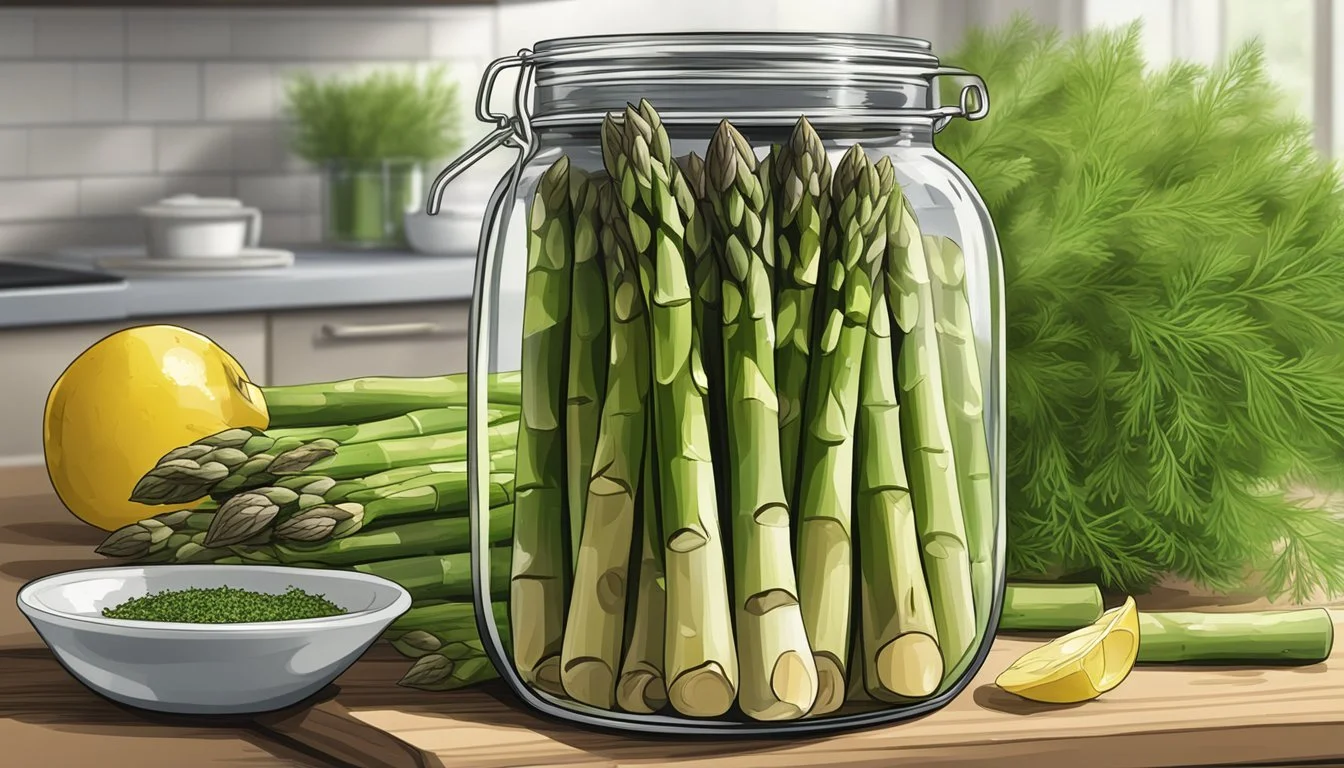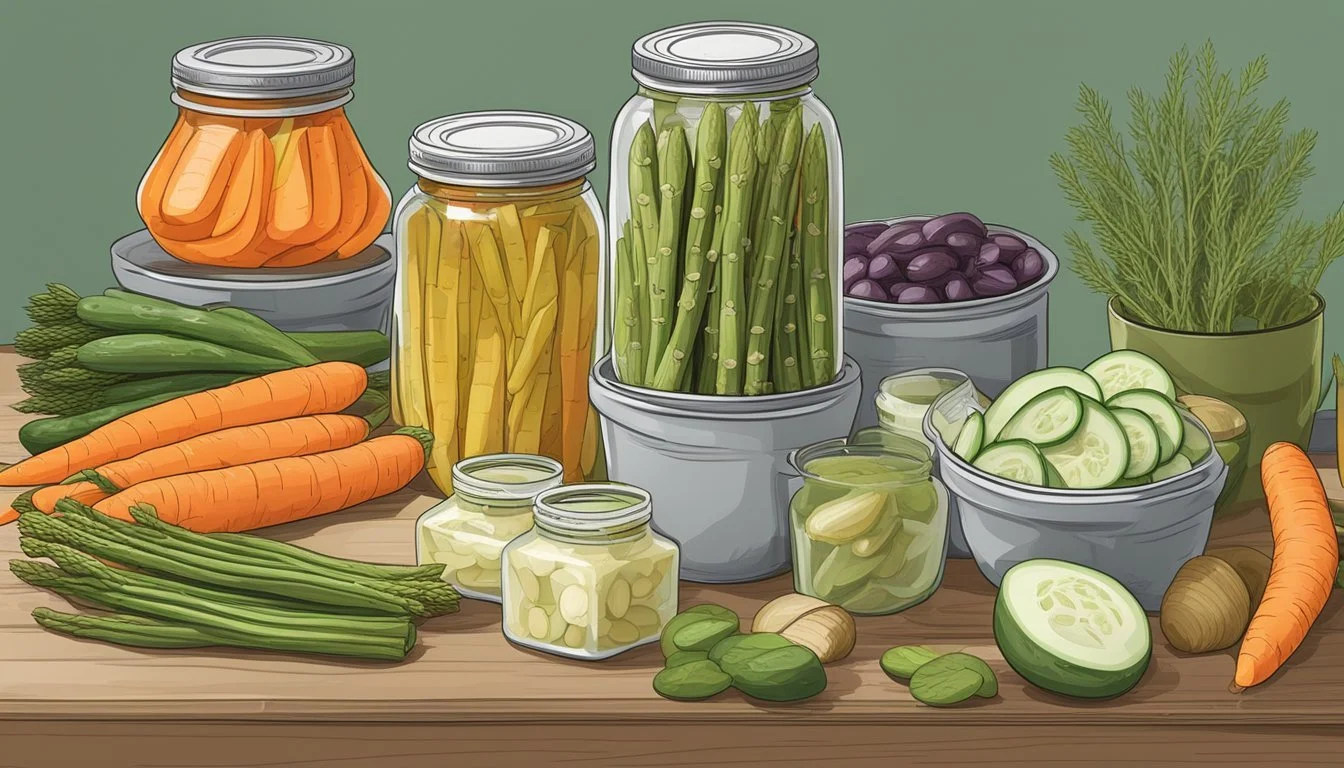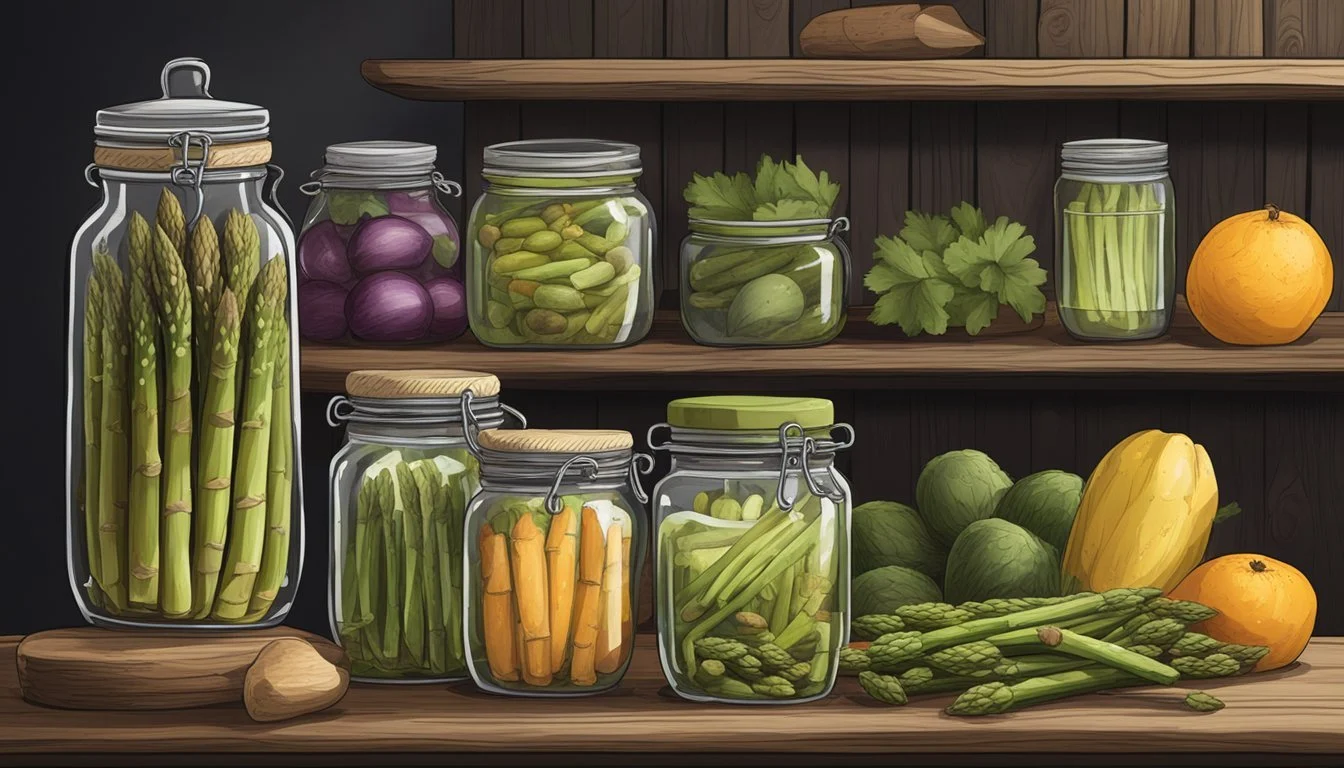Pickled Asparagus Substitutes
Best Alternatives for Your Recipes
Pickled asparagus adds a tangy crunch to everything from salads to charcuterie boards. When it’s not available, finding a suitable substitute can maintain the desired flavor and texture in your dishes. Pickled green beans and pickled carrots can serve as excellent alternatives, offering a similar crisp and savory kick.
Another viable option is pickled okra, which shares the same briny zest and firm bite. These substitutes not only mimic the texture of pickled asparagus but also introduce a slightly different yet delightful flavor profile. For those specific recipes where pickled asparagus is essential, these vegetables can still provide a satisfying replacement without compromising on taste.
Pickled cucumbers, commonly known as gherkins or pickles, also work well as a substitute. They bring a familiar tanginess and can easily match the asparagus in various culinary applications. Ensuring that the substitute you choose fits your recipe’s flavor and texture requirements will keep your dishes as enjoyable as ever.
Understanding Pickled Asparagus
Pickled asparagus is a versatile and flavorful addition to many dishes. This preserved vegetable involves soaking asparagus spears in a brine composed of vinegar, water, salt, and sugar.
The pickling process typically starts with washing the asparagus thoroughly. The spears are then trimmed to fit neatly into jars, allowing about 1/2-inch headspace. This ensures they are well-submerged in the brine.
The brine itself is crucial. It usually consists of vinegar and water mixed with pickling salt and sugar. These ingredients are brought to a boil, ensuring the salt and sugar dissolve completely.
Optional spices such as garlic, mustard seeds, and dill can be added to enhance the flavor. Crushed red pepper flakes and peppercorns are also popular additions.
After preparing the brine, it is poured over the asparagus spears in the jar. Care should be taken to fully submerge the spears. The jars are then sealed with lids.
For those looking at long-term storage, canning can be used. This involves processing the jars in a water bath canner for about 15 minutes, making the pickled asparagus shelf-stable for up to 12-18 months.
Blanching asparagus before pickling is another step that some recipes include. This involves briefly boiling the asparagus spears and then shocking them in ice water to maintain their color and crispness.
Overall, pickled asparagus offers a tangy, crunchy treat that can enhance salads, charcuterie boards, and many other dishes.
Essential Ingredients for Pickling Asparagus
To prepare delicious pickled asparagus, specific ingredients play critical roles in ensuring flavor and texture. These ingredients include various types of vinegar, essential spices, seasonings, and specific balances of sweetness and saltiness.
Vinegar Varieties
Vinegar is crucial in pickling asparagus, both for its preservation properties and its flavor. White vinegar and apple cider vinegar are popular choices. White vinegar provides a sharp, clear acidity, while apple cider vinegar adds a hint of fruitiness. Some recipes mix these two to balance the flavors. Ensuring the vinegar’s acidity level is at least 5% is important for safe preservation.
Spices and Seasonings
The spices and seasonings contribute significantly to the taste of pickled asparagus. Garlic cloves, mustard seeds, dill seeds, black peppercorns, and red pepper flakes are commonly used. Fresh dill often enhances the traditional dill pickle flavor. These spices should be tailored to personal taste preferences. For example, increasing the red pepper flakes will add more heat.
Sweetness and Saltiness
The right balance of sugar and salt is essential. Granulated sugar and different salts like sea salt, kosher salt, and canning salt are typically used. The sugar adds a subtle sweetness that complements the vinegar’s acidity, while the salt enhances the overall flavor. Care must be taken to avoid using iodized salt, as it can cause cloudiness in the pickling brine. Balancing these elements ensures a harmonious flavor profile.
Pickling Process and Techniques
Effective pickling of asparagus involves careful preparation of the spears, crafting the right pickling brine, and ensuring proper canning techniques for preservation.
Preparing Asparagus for Pickling
Begin with fresh asparagus to achieve the best results. Wash the asparagus well under running water, ensuring all dirt and impurities are removed. Trim the woody ends off the asparagus spears. Measure the spears against the canning jars to ensure a proper fit, leaving about 1/2-inch headspace at the top. Peel and wash garlic cloves if you plan to add them to the jar for additional flavor.
Blanching the asparagus is an optional step but can help retain its vibrant color. Bring a saucepan of water to a boil, blanch the asparagus for 2 minutes, then immediately transfer them to an ice water bath to halt the cooking process. Dry the spears before placing them in the jars.
Creating the Pickling Brine
The flavor of pickled asparagus largely depends on the pickling brine. In a saucepan, combine equal parts of vinegar and water. Popular choices are white vinegar or apple cider vinegar for their sharp flavor profiles. Add salt and sugar to taste, along with optional spices such as mustard seeds, peppercorns, and red pepper flakes.
Bring the mixture to a rolling boil to dissolve the salt and sugar thoroughly. Pour the hot brine over the prepared asparagus in the jars, ensuring the spears are fully submerged. This mixture will preserve the asparagus by creating an acidic environment that inhibits the growth of bacteria.
Canning and Storage
Proper canning techniques are crucial for long-term storage. Divide the asparagus and any added flavorings, such as dill sprigs and garlic cloves, among sterilized mason jars. Leave about 1-inch headspace at the top of each jar.
For a water bath canner method, place the sealed jars in boiling water and process for about 15 minutes. Ensure the lids seal properly to create a vacuum that prevents spoilage. Store the jars in a cool, dark place. If not canning, refrigerate the pickled asparagus and consume within a few weeks.
Properly canned pickled asparagus has a shelf life of 12-18 months, making it a long-lasting pantry staple.
Substitutes for Pickled Asparagus
There are several pickled vegetables that can serve as an alternative to pickled asparagus. Each offers unique flavors and textures that can enhance your dishes.
Alternative Pickled Vegetables
Pickled Radishes: Radishes have a crisp and slightly spicy profile that becomes tangy when pickled. They add a bright color and zesty taste to dishes, making them a good substitute for pickled asparagus in salads and sandwiches.
Pickled Cauliflower: This vegetable pickles well, retaining a firm texture. It provides a mild, slightly sweet flavor, and its crunchy bite can replace asparagus in antipasto platters or charcuterie boards.
Pickled Green Beans: These beans offer a similar crunch to asparagus but with a different taste. They work well as a snack or as a crunchy addition to salads and vegetable trays.
Pickled Beets: Beets are sweet and earthy, with a vibrant color that stands out. When pickled, they add a unique, slightly sweet tang to dishes, perfect for salads or alongside meats.
Pickled Cucumbers: Often simply called pickles, these are versatile and commonly available. They provide a similar acidity and crunch, making them a good stand-in for pickled asparagus in most recipes.
Pickled Eggs: Though unusual, pickled eggs bring a rich, tangy flavor and protein content. They can be used as a savory snack or sliced into salads, adding a different but complementary element.
Nutritional Information
When considering substitutes for pickled asparagus, evaluating their nutritional profiles is essential. Below is a comparison of several common substitutes, focusing on calories, fat, fiber, protein, sodium, and carbohydrates.
Fresh Asparagus
Calories: 20 per 100g
Fat: 0.2g
Fiber: 2.1g
Protein: 2.2g
Sodium: 2mg
Carbohydrates: 3.9g
Zucchini
Calories: 17 per 100g
Fat: 0.3g
Fiber: 1.0g
Protein: 1.2g
Sodium: 8mg
Carbohydrates: 3.1g
Green Beans
Calories: 31 per 100g
Fat: 0.1g
Fiber: 3.4g
Protein: 1.8g
Sodium: 6mg
Carbohydrates: 7.1g
Broccoli
Calories: 34 per 100g
Fat: 0.4g
Fiber: 2.6g
Protein: 2.8g
Sodium: 33mg
Carbohydrates: 6.6g
Each vegetable offers a unique set of nutrients. For instance, zucchini provides a low-calorie option with a good amount of fiber and carbohydrates.
Green beans are higher in fiber compared to asparagus and zucchini, making them a great choice for those looking to increase their fiber intake.
Broccoli, known for its higher protein content, also supplies substantial fiber and carbohydrates, making it a nutrient-dense substitute.
Pickled versions of these veggies will generally have higher sodium content due to the brining process. Always check nutritional labels or recipes for specific details.
Serving and Pairing Ideas
Pickled asparagus is a versatile ingredient that can be enjoyed in several ways, from appetizers to garnishes. They bring a tangy, crisp element to various dishes, enhancing the flavor profile with minimal effort.
As an Appetizer or Snack
Pickled asparagus can be served as a standalone snack or part of a charcuterie board. Their tangy flavor pairs well with cured meats, cheeses, and olives.
Additionally, they fit perfectly in a relish tray, providing a crispy, pickled contrast to fresh vegetables. For a simple appetizer, wrap the asparagus spears in prosciutto and serve with different dipping sauces.
Culinary Creations
Incorporate pickled asparagus into sandwiches for an added crunch and zesty flavor. They work well in cold sandwiches, particularly with deli meats or egg salad.
Add them to a Bloody Mary as a sophisticated garnish, adding both visual appeal and a burst of acidity. They can also be chopped and mixed into an egg salad for a briny twist on the classic recipe.
Accompaniments and Garnishes
Use pickled asparagus as an accompaniment to grilled meats or as a side with seafood dishes. The acidity cuts through rich flavors, adding balance to the meal.
They make a stylish garnish for cocktails like Bloody Marys, adding a unique touch to your drink presentations. Whether used as a visual enhancement or a flavor enhancer, pickled asparagus elevates the dining experience.
Tips for Perfect Pickled Asparagus
To achieve perfect pickled asparagus, preparation is key. Start by trimming the asparagus to fit your jars, usually about 4-5 inches in length.
Blanch the asparagus for 1-2 minutes, then transfer to an ice bath to cool to room temperature. This helps the asparagus retain its crunch.
Use simple ingredients like garlic, dill, mustard seeds, and peppercorns. Combining these with vinegar, water, sugar, and salt creates the classic tangy brine.
For a quick pickling method, arrange the asparagus spears vertically in jars and pour the boiling brine over them. Allow them to cool before sealing.
Adjust the prep time based on whether you are doing a quick pickle or a process that requires canning. Quick pickled asparagus can be ready in a few hours.
Using fresh asparagus at the peak of asparagus season ensures the best flavor and texture.
Recipe cards can be handy for keeping track of ingredient measurements and steps, ensuring consistency.
Always ensure the asparagus is fully submerged in the brine to prevent spoilage and ensure even flavoring.
Health and Safety Considerations
When preparing pickled asparagus substitutes, safety is paramount. The initial step involves ensuring the use of fresh, high-quality vegetables. Spoiled or damaged produce can harbor harmful bacteria.
Research indicates that maintaining an acidic environment is crucial. An acidic brine, typically involving vinegar, inhibits the growth of bacteria and ensures the safety of the final product.
Proper sterilization of jars, lids, and utensils is essential. This step helps eliminate any potential pathogens before packing the vegetables. Sanitizing equipment in boiling water for a few minutes achieves this goal.
Using a water bath canner provides an extra layer of protection. Process the jars in boiling water according to the recommended times, ensuring any remaining bacteria are eradicated. Adjust processing times if you are at a higher elevation.
Avoid using table salt in pickling recipes, as it contains additives that can affect the preservation process. Pickling salt is free from these additives and ensures a safe, high-quality product.
Finally, pay attention to the storage conditions of the pickled substitutes. Store them in a cool, dark place to maintain their safety and flavor. Always inspect jars for signs of spoilage such as gas bubbles or a foul smell before consumption.
Conclusion
Finding substitutes for pickled asparagus is easier than it seems.
Broccoli and Broccolini are excellent alternatives, offering a similar flavor and texture profile. Broccoli has an earthy taste, while broccolini tends to be sweeter and more tender.
Zucchini is another great option. Though it has a different texture, its mild flavor and buttery consistency make it a good stand-in.
Pickled carrots can also work well. They provide a crunch and a hint of sweetness that mimics the pickled asparagus experience.
Green beans can replace pickled asparagus in many recipes. They absorb brine well and maintain their firmness, providing a satisfying bite.
Experimenting with these alternatives can keep meals interesting and delicious. The key is to match the texture and flavor to the original as closely as possible.









